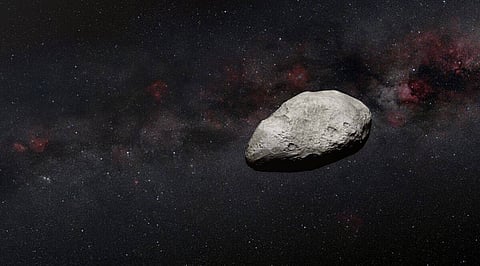
- Home
- Career Counseling
- Bharat
- Editorials
- Research
- Religion and Culture
- Corporate (Business News )
- State News Update
- Crimes News
- Education News
- Property News
- mocktest
- Life Style

An international team of astronomers used the James Webb Space Telescope to detect a previously unknown asteroid, which measures between 100 and 200 metres, or about the size of the Colosseum in Rome. According to the European Space Agency (ESA), the asteroid is likely the smallest object observed to date by Webb.
“We — completely unexpectedly — detected a small asteroid in publicly available MIRI calibration observations. The measurements are some of the first MIRI measurements targeting the ecliptic plane and our work suggests that many, new objects will be detected with this instrument,” said Thomas Müller, lead author of the study published in the journal Astronomy & Astrophysics, in a press statement. Müller is an astronomer at the Max Planck Institute for Extraterrestrial Physics in Germany.
The James Webb Space Telescope observations that the scientists used were not originally made to hunt for new asteroids. In fact, they were calibration images of the main-belt asteroid (10920) 1998 BC1. Researchers initially considered the images to have failed because of the brightness of the target and the offset pointing of the telescope.
But despite this, data from the asteroid 10920 were used by the team to test and establish a new technique to determine an object’s orbit and estimate its size. The scientists tested and validated this for the asteroid 10920 using data from Webb’s MIRI (Mid-Infrared Instrument), ESA’s Gaia mission and ground-based telescopes.
“Our results show that even ‘failed’ Webb observations can be scientifically useful, if you have the right mindset and a little bit of luck. Our detection lies in the main asteroid belt, but Webb’s incredible sensitivity made it possible to see this roughly 100-metre object at a distance of more than 100 million kilometres,” added Müller.
The research team suspects that the newly-discovered asteroid is the smallest object observed to date by Webb and according to ESA, it could also be the smallest detected in the main belt. If the detection is confirmed as a new asteroid discovery, it could have important implications for scientists’ understanding of the formation and evolution of the solar system, according to ESA.
The mainstream media establishment doesn’t want us to survive, but you can help us continue running the show by making a voluntary contribution. Please pay an amount you are comfortable with; an amount you believe is the fair price for the content you have consumed to date.
happy to Help 9920654232@upi
